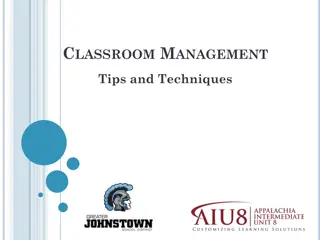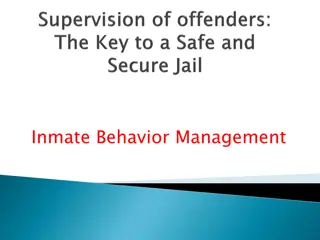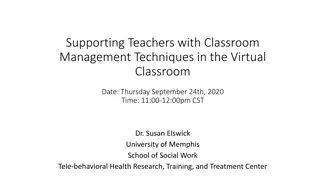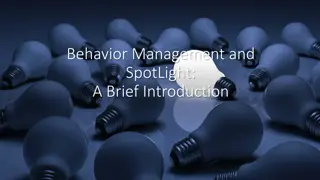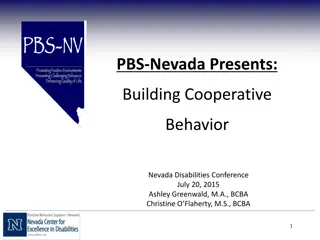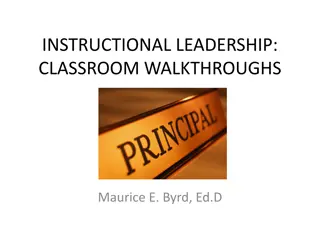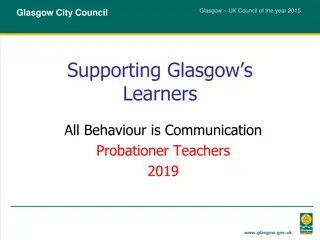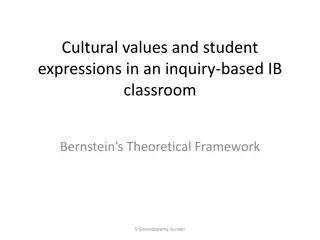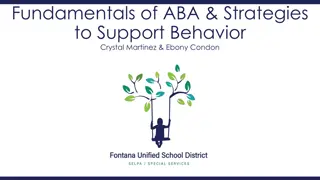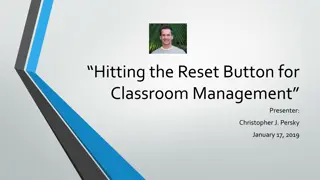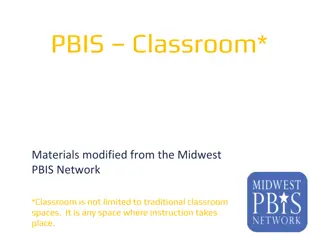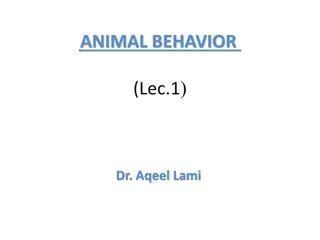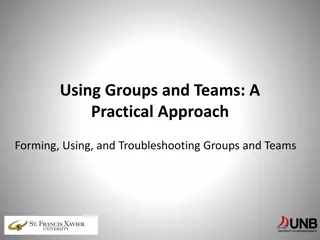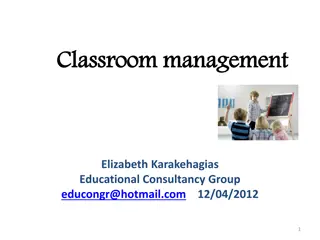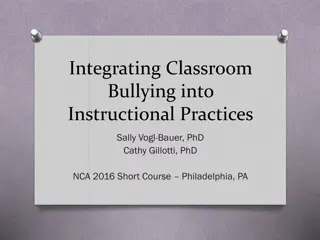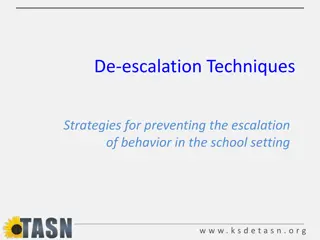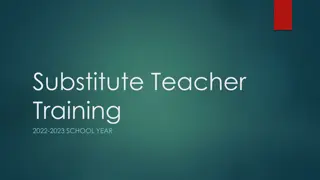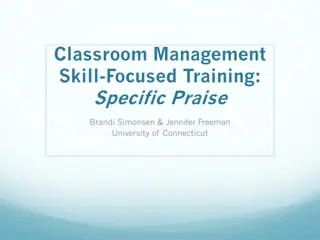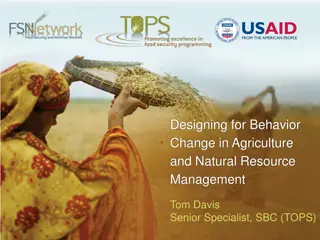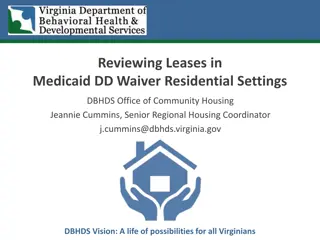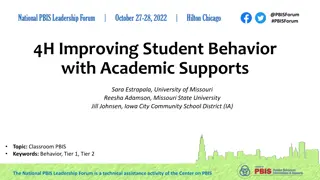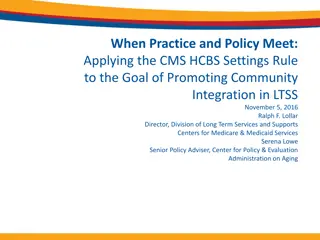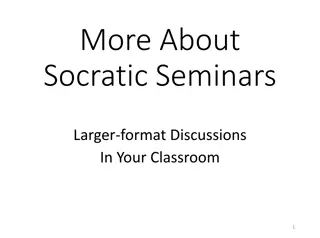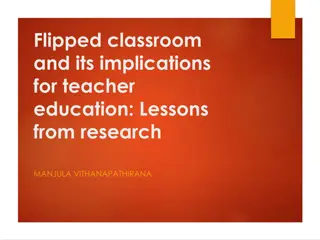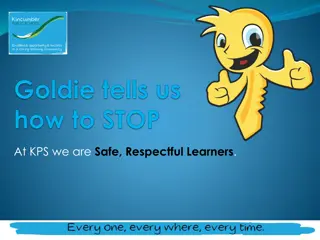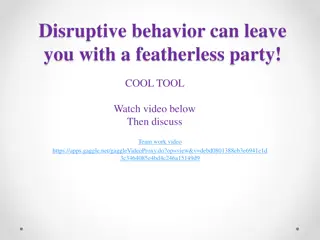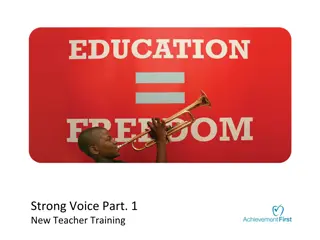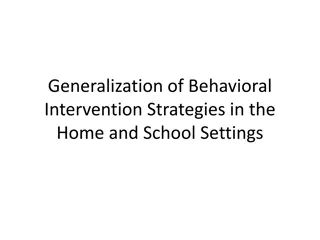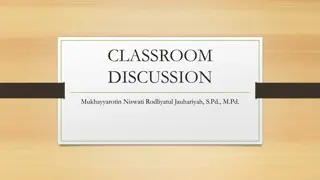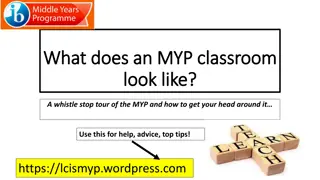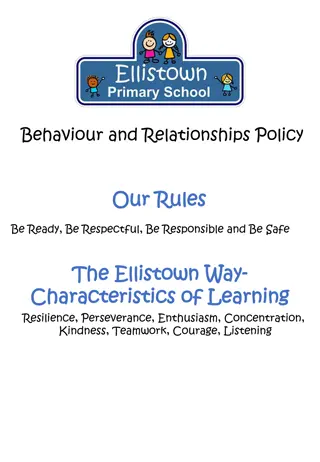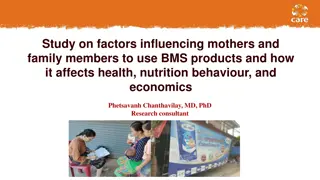Understanding Behavior Management in Classroom Settings
Explore the essential topics of behavior management, classroom strategies, and discipline in educational settings. Delve into the functions of behavior, impact of trauma on learning, and effective management techniques. Learn how to identify underlying reasons for student behaviors, discuss behavior facts, define behavioral concerns, and implement data recording for behavior analysis. Gain insights into the relationship between behavior and the environment from an ecological and observational learning perspective.
Uploaded on Sep 16, 2024 | 0 Views
Download Presentation

Please find below an Image/Link to download the presentation.
The content on the website is provided AS IS for your information and personal use only. It may not be sold, licensed, or shared on other websites without obtaining consent from the author. Download presentation by click this link. If you encounter any issues during the download, it is possible that the publisher has removed the file from their server.
E N D
Presentation Transcript
BEHAVIOR MANAGEMENT: CLASSROOM MANAGEMENT & DISCIPLINE Dr. Megan Kirk Dr. Amy Walker Blumberg Center March 1, 2018
AGENDA Introductions Functions of Behavior Impact of trauma on learning Discipline and classroom management strategies
JUST BEHAVE! Behavior is not random, but follows purposeful patterns. Students who present with the same apparent surface behaviors may have very different drivers (underlying reasons) that explain why those behaviors occur. A student s problem behaviors must be carefully identified and analyzed to determine the drivers that support them.
BEHAVIOR FACTS Talk about behaviors, not judgments behavior is not random or evil Inappropriate behaviors are learned and predictable A child s inappropriate behavior is his/her best effort to communicate Setting/people influence child s behavior
BEHAVIOR DEFINED Actions or events that can be observed, measured, and repeated Seen Counted Done again Behaviors? Lazy Bad attitude Aggressive
DEFINING BEHAVIORAL CONCERNS Define the problem behavior in clear, observable, measurable terms Develop examples and non-examples of the problem behavior. Write a behavior hypothesis statement. Select a replacement behavior. Write a prediction statement.
BASIC DATA SHEET FOR EVENT RECORDING Student: ____________________ Observer: ___________________ Behavior: ___________________ Date Time Notations of Occurrence IIII IIII IIII IIII III IIII IIII IIII III Total Occurrences Start Stop 10:00 -- 10:15 10:00 10:15 01/12/16 01/13/16 23 18
BEHAVIOR + WORLD VIEW Ecological: May be a method of communicating with the environment Observational Learning: May be a learned behavior that serves a purpose for the child (it gets them what they want) Behaviorism: May be related to specific antecedents (what happens before the behavior) and consequences (what happens after the behavior) Determining what the function or reinforcer for the behavior enables us to understand the purpose of the child s behavior Common Denominator: Antecedents or consequences (e.g., reactions to the problem behavior) often shape the behavior.
THE ABCS OF BEHAVIOR Antecedent Behavior Consequence Occur immediately before a behavior Potential triggers for problem behavior Can affect the frequency and intensity of behavior Examples Difficult or excessive tasks Denial of desired items or activities
FUNCTIONS OF BEHAVIOR Some common drivers Power/control/access Protection/escape/ avoidance Attention Acceptance/affiliation/ gratification Justice/revenge Some common types: Aggression, self-injury, property destruction, disruption, elopement Some effects: Risk of physical harm, lack of social development leads to isolation, skill acquisition deficits, independent skill deficits (long-term care), family stress
IDENTIFYING THE GOALS OF BEHAVIORS Access something Attention: adult or peer attention Avoid something Attention: hiding from peers or adults Tangibles: want object Tangibles: destroys objects Sensory: good feelings Sensory: discomforting feelings
FUNCTIONAL BEHAVIORAL ASSESSMENT Phase 1: Form FITS Frequency Intensity Duration/Time Setting Previous Interventions Educational Impact
FBA Statements of function Provides information relevant to decision making Communicates the function of the behavior to people of different backgrounds Contains much of the information needed to develop a function-based intervention ABC A: anything in the environment that may influence behavior prior to the actualization of the target behavior. B: what the person does C: reinforcement/punishment
IMPACT OF TRAUMA ON LEARNING
WHAT IS TRAUMA? An exceptional experience in which powerful and dangerous stimuli overwhelm the child s capacity to regulate emotions. Trauma results from an event, series of events, or set of circumstances that is experienced by an individual as physically and emotionally harmful or threatening and that has lasting adverse effects on the individual s physical, social, emotional, or spiritual well-being. Not all experiences of trauma lead to a trauma response. Many variables impact the process Child Traumatic Stress is when children are exposed to traumatic events/experiences and the exposure overwhelms their ability to cope.
WHY IS UNDERSTANDING TRAUMA IMPORTANT? 1 out of every 4 children attending school has been exposed to a traumatic event that can affect learning and/or behavior Trauma can impact school performance. Lower GPA, higher absence rate, decreased reading ability, increased behavior problems Trauma can impair learning. Chronic exposure can adversely affect attention, memory, and cognition, interfere with problem solving, result in overwhelming feelings of frustration and anxiety Traumatized children may experience physical and emotional distress You can help a child who has been traumatized.
WHAT TYPES OF EXPERIENCES WOULD LIKELY BE TRAUMATIC FOR YOUTH? Natural disasters Forced displacement War/terrorism Emotional, physical, or sexual abuse, assault or neglect Serious accident or illness/medical procedure Victim/Witnessing Domestic Violence Community Violence School Violence Interpersonal Violence
ADVERSE CHILDHOOD EXPERIENCES (ACES) Inherently disruptive experiences in childhood that produce significant and potentially damaging levels of stress and associated physical changes Potentially traumatic events in a child s life that can have negative, lasting effects on health and well-being. More than 68% of children have experienced a possible traumatic event by age 16
WHAT ARE THE 10 ACES? Child Sexual Abuse Child Physical Neglect Child Physical Abuse Child Emotional Abuse Child Emotional Neglect Witnessing Domestic Violence Against the Mother Loss of a Parent to Death or Abandonment Mentally Ill, Depressed, or Suicidal Family Member Incarceration of a Family Member Drug Addicted or Alcoholic Family Member
EXAMPLES OF RESILIENCE TO OVERCOME ACES Attachment to a caring adult Hope The ability to calm oneself Verbally saying I love you Learning to ask for help Acknowledging when you are wrong Trust Having clear expectations and rules A sense of belonging Learning how to self-advocate Helping a child develop problem-solving skills Showing empathy Giving a child choices Learning to show appreciation Establishing consequences Developing a sense of control Allowing a child to experience success and failure Letting a child know that you are available to help
WHAT ABOUT NEGLECT? Failure to provide for a child s basic needs Perceived as trauma by a young child who is completely dependent on adults for care Opens the door to other traumatic events May interfere with a child s ability to recover from trauma
THE EFFECTS OF TRAUMA Impairs memory, concentration, new learning, and focus. Linked to heart disease, obesity, addiction, pulmonary illness, diabetes, autoimmune disorders, cancer Impacts an individual s ability to trust, cope, and form healthy relationships Disrupts emotion identification, ability to self-soothe or control expression of emotions, and one s ability to distinguish between what s safe and unsafe Shapes a person s belief about self and others, one s ability to hope, and one s outlook on life
TRAUMA AND THE DEVELOPING BRAIN Trauma is a neuro-developmental insult and impacts the development of the brain. When triggered into a trauma response over and over, there are major multi-systemic impacts on the developing brain Brain architecture is experience dependent (neuroplasticity) www.changingminds.org
KEY INSIGHT: Because of constant exposure to violence and trauma, children and youth can become locked in a permanent state of fight/flight. This makes these children and youth react to normal experiences as if they were life and death threats. This is not a rational/cognitive process. It is wired into their physiological response.
TRAUMA REMINDERS Things, events, situations, places, sensations, and even people that a youth consciously or unconsciously connects with a traumatic event What is insignificant to a child who has not been traumatized can be seen as very threatening to a child who has been traumatized. The latter then responds in a way that seems to be out of proportion with the situation to the uninformed observer
EXAMPLES OF TRAUMA REMINDERS A seven-year-old boy whose father and older brother fought physically in front of him becomes frantic and tries to separate classmates playfully wrestling on the school playground. A ten-year-old physically abused boy who is innocently bumped by another student passing him in the classroom erupts in anger, tackling the child to the ground. A teenage girl who was abused by her stepfather refuses to go to PE class after meeting the new PE teacher who wears the same aftershave as her stepfather. When someone is reminded of an old trauma, it becomes a state and they physiologically and psychologically return to the time they were traumatized.
TRAUMA-INFORMED CONSEQUENCES Make an effort not to exclude student from school. Shape behavior by helping youth recognize the impact of their actions on themselves and their community. Build youth s capacity to manage strong emotions. Invest great energy, creativity, and resources upfront in order to support young people s long-term success. Take the long view and understand that behavior change is slow and incremental.
IMPACT OF TRAUMA ON SCHOOL PERFORMANCE Trauma can impact school performance Decreased reading ability Lower GPA Higher rate of school absences Increased drop-out More suspensions and expulsions Decreased reading ability
WHAT IS A TRAUMA-SENSITIVE SCHOOL? A safe and respectful environment that enables students to: Build caring relationships with adults and peers, Self-regulate their emotions and behaviors, and Succeed academically, while supporting their physical health and well-being
WHY WE NEED TRAUMA SENSITIVE SCHOOLS All students need safe and supportive schools. Traumatic experiences can impact learning, behavior, and relationships at school. Trauma-sensitive schools focus on what the adults do How the adults can support students by making small changes Shift in mindset https://traumasensitiveschools.org/why/
Children have a natural love for learning yet what we as a collective society have forgotten is that children are first emotional beings. They operate at an emotional level, not an intellectual level. That's the definition of being a child. Trusting the process of meeting the social and emotional needs of our students to achieve high test- scores and successful graduation rates is the ultimate in making the shift to a trauma-informed school. Trauma compromises a child s ability to regulate themselves. (Beyond Consequences in the Classroom, 2016)
TRAUMA-INFORMED PRACTICES: HAVE A PLAN Being trauma-informed includes having a plan for when you feel a child is in need of treatment, is receptive to help, or self-discloses trauma or abuse to you. What s your comfort level in talking with young people about trauma they may have experienced? Do you know referral sources for mental health treatment, how to make referrals, connect the youth to resources, and follow up if appropriate?
CHANGING THE QUESTION From What is wrong with you? to What is going on? How are you feeling? Behavior Feeling it is masking Fear of Rejection/Abandonment Overwhelmed Hurt Lack of Self Worth Avoidance of Emotions Testing Relationship Triggered Trauma Memories Need for Control Oppositional Behavior Outbursts Anger Depression Withdrawal/Absences Argumentativeness Escalation Defiance of Authority
AVOIDING RE-TRAUMATIZATION The extent to which students will be affected by a traumatic event may depend on how often they are reminded of the trauma and the nature and severity of secondary stresses. Trauma-sensitive schools acknowledge the prevalence of traumatic occurrence in students lives and create a flexible framework that provides universal supports, is sensitive to unique needs of students, and is mindful of avoiding re-traumatization.
AVOIDING RE-TRAUMATIZATION Help teachers understand that children may not be able to express their suffering in ways that adults can understand Emphasize the importance of helping children feel safe Create support systems for teachers to develop classroom strategies for addressing the needs of traumatized children Adapt school curricula and procedures to respond to the needs of traumatized children Develop protocols for early identification and services before children are at risk for discipline or school failure
IMPACT OF TRAUMA ON LEARNING AND DEVELOPMENT Trauma can impair the acquisition of developmental competencies in Cognitive functioning Emotional regulation Interpersonal relationships Brain is activated (alarm state); children feel vulnerable and unsafe. Cannot shift to calm state necessary for learning Children develop coping strategies that are not understood by the adults in their lives, or by themselves, which often contribute to secondary problems, like disciplinary actions.
IMPACT OF TRAUMA ON LEARNING AND DEVELOPMENT Acute trauma can impair concentration and memory Intrusive thoughts, interrupted sleep, nightmares Moodiness, frustration, anger, social withdrawal Chronic trauma can result in Executive functioning deficits impacting goal setting, organizing, planning, anticipating consequences Lack of internal maps ; distorted inner representations of world Poor relationships with school staff and peers that impact learning
IMPACT OF TRAUMA ON LEARNING AND DEVELOPMENT I found it difficult to hear Mrs. Patterson when she spoke in the classroom. I felt as if she were speaking from beneath tumbling water, or from the end of a long tunnel. She assumed I was daydreaming I could see the math teacher s mouth moving but couldn t hear a thing. It was as if I were in a soundless chamber I just couldn t process a word of it.
IMPACT OF TRAUMA ON LEARNING AND DEVELOPMENT Trauma in early childhood can have a detrimental effect of the developing brain. Brain structures that regulate emotion, memory, and behavior can be smaller in size; decreased integration of brain hemispheres and irregular brain activity correlated with poor emotional control and aggression Abnormally high levels of stress hormones
IMPACT OF TRAUMA ON BEHAVIOR Anxious, withdrawn Difficulty with impulse control Impaired short term memory Confusion, disorientation Acting out On edge Daydreaming Be aware of both the children who act out AND the quiet children who do not appear to have behavioral problems.
IMPACT OF TRAUMA: BEHAVIOR OVER TIME Poor hygiene, appearance Deterioration in relationships Sleeping/eating Academic failure Use of drugs or alcohol Avoidance of people or places Increase in discipline issues Absenteeism
EXAMPLES OF TRAUMA-INFORMED CARE IN PBIS CONTEXT Tier 1: Universal School policies, culture, and climate establish a physically and emotionally safe climate Discipline policies balance accountability with an understanding of trauma Activities are structured in predictable and emotionally safe ways Prompt intervention for behaviors by students or adults that are inconsistent with this standard (e.g., bullying) Ongoing professional development opportunities about trauma occur as determined by staff needs assessments
EXAMPLES OF TRAUMA-INFORMED CARE IN PBIS CONTEXT Tier 2: Supplemental Support Screening students for trauma symptoms to determine if other assessments or referrals are warranted Building consultation teams that support classroom teachers efforts to be more responsive to students affected by trauma
EXAMPLES OF TRAUMA-INFORMED CARE IN PBIS CONTEXT Tier 3: Intensive Intervention Teacher/environmental interventions that identify triggers and develop strategies to reduce and address these issues Comprehensive functional behavior assessments coupled with intensive, evidence-based trauma interventions to teach individual students alternative, appropriate methods to meet their needs.
RYANS STORY Ryan is an 8th grade boy. This morning, when he arrived at school, his teacher asked him for his homework and Ryan did not have it. She expressed frustration and took away his recess as a consequence. A short time later, his desk-mate accidentally bumped Ryan. Ryan punched him in the stomach. His teacher, upset by this outburst, began to yell at Ryan to stop. Ryan began to scream, kick chairs, and hide under his desk. After 10 minutes of trying to get Ryan out from under the desk, he was brought to the principal s office and given a five-day suspension for fighting and disruptive behavior.
RYANS STORY THROUGH A TRAUMA LENS Ryan is an 8th grade boy from a highly under-resourced neighborhood. He has been witnessing severe domestic violence between his parents since he was a baby. One night, in front of Ryan, his father beat up and injured his mother so badly that a neighbor called the police; his father was handcuffed and taken away by the police, and his mother was taken in an ambulance to the hospital. Ryan slept little that night, terrified and anxious what would happen to his mother and father. In the morning, Ryan s neighbor took him to school. This morning, when he arrived at school, his teacher ( who did not know about Ryan s traumatic experience) asked him for his homework. When he did not have it, she expressed frustration and took away his recess as a consequence. Ryan was upset and triggered by being in trouble with his teacher.



